Feedback is essential for success in the workplace. But how can it be provided effectively? Receiving criticism is challenging, but essential for personal growth. Often, well-intentioned advice can be met with resistance. As a leader or team member, the right feedback methods can make a difference. They provide a structure to make opinions more tangible and facilitate communication. There are a variety of feedback methods available to promote the constructive use of feedback.
What is Feedback?
What Feedback Should Be:
Descriptive Instead of Judgmental
Feedback should communicate specific observations and experiences without being judgemental.
Balanced
Balanced feedback includes both praise and constructive criticism (the sandwich method).
Specific
Feedback should refer to specific situations and examples to make it more comprehensible.
Free From Interpretations
Feedback should be based on facts, not assumptions.
Subjectively Formulated
“I noticed” instead of “You did”.
Actionable
Feedback should focus on behaviors that the recipient can actively change.
What Feedback Should Not Be
Personal or Derogatory
Criticism should solely address behavior, not the person themselves.
Overloaded
Too much criticism at once can be overwhelming and reduce effectiveness.
Absolute Statements
Terms like “always” or “never” should be avoided.
Not Constructive or Solution-Oriented
The feedback given should identify possible solutions for the future and not just list problems.
KEY POINTS
- Good feedback is characterized by specific, non-judgmental, and balanced responses that aim to promote individual development and strengthen communication.
- There are a variety of feedback methods, each offering an individual approach to structuring and delivering feedback effectively.
- When selecting the appropriate method, specific questions about context and objectives can provide guidance.
Why Is Good Feedback So Important?
Good feedback is crucial, regardless of the context. It draws attention to unconscious or inappropriate behaviors in a constructive manner and provides an opportunity for personal development. Furthermore, feedback allows for a comparison between self-perception and external perception, promoting a realistic self-image. Well-structured feedback not only allows companies to optimize their employees’ performance, but ideally also improves the quality of their products and processes. It contributes to creating a transparent communication culture and encourages open exchange of ideas and perspectives. Additionally, feedback helps employees learn how to handle criticism constructively and actively participate in the improvement process. This can positively impact employees’ sense of responsibility and motivation, as they perceive themselves as significant contributors to the company.
The Five-Finger Feedback Method
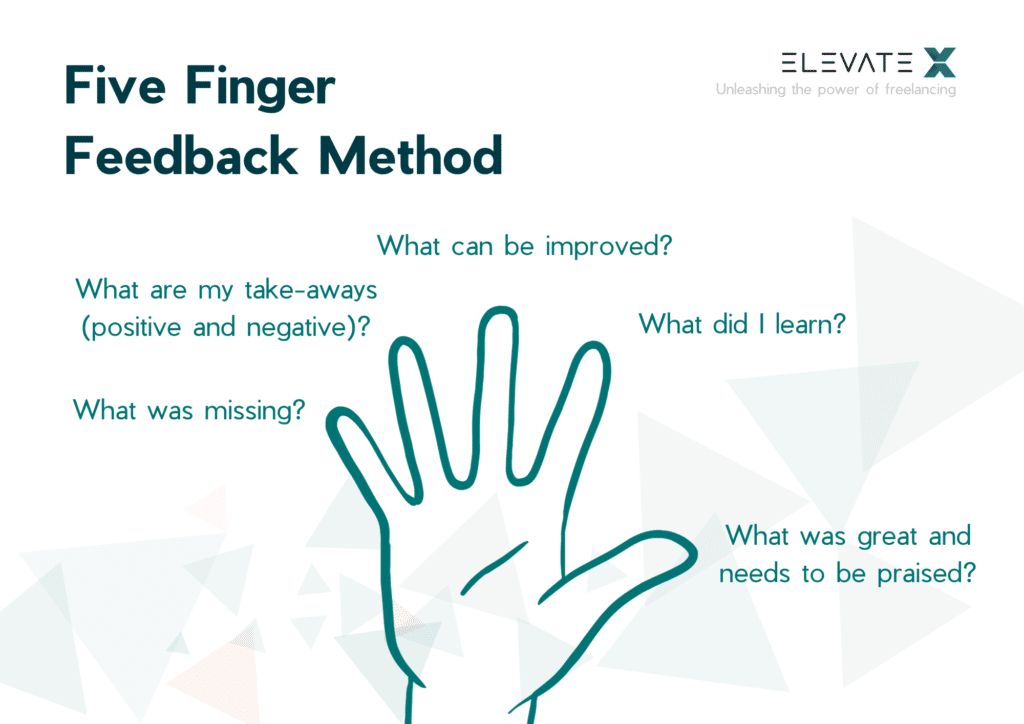
A proven method for giving targeted and constructive feedback is the Five-Finger Feedback Method.
How does it work?
Each employee first draws their handprint on a piece of paper or receives a template. Each finger represents a specific type of feedback, which employees note down in bullet points.
- Thumb – What was great and needs to be praised?
- Index finger – What did I learn?
- Middle finger – What can be improved?
- Ring finger – What are my take-aways (both positive and negative)?
- Pinky finger – What was missing?
Example:
Application in a team meeting after a joint project, where team members want to provide constructive feedback on their collaboration.
The Five-Finger Feedback Method allows for structured and comprehensive feedback. It provides a clear structure and helps cover various aspects of feedback, from praise and recognition to specific improvement suggestions. This method creates a constructive feedback culture that promotes individual and collective growth.
The Traffic Light Feedback Method
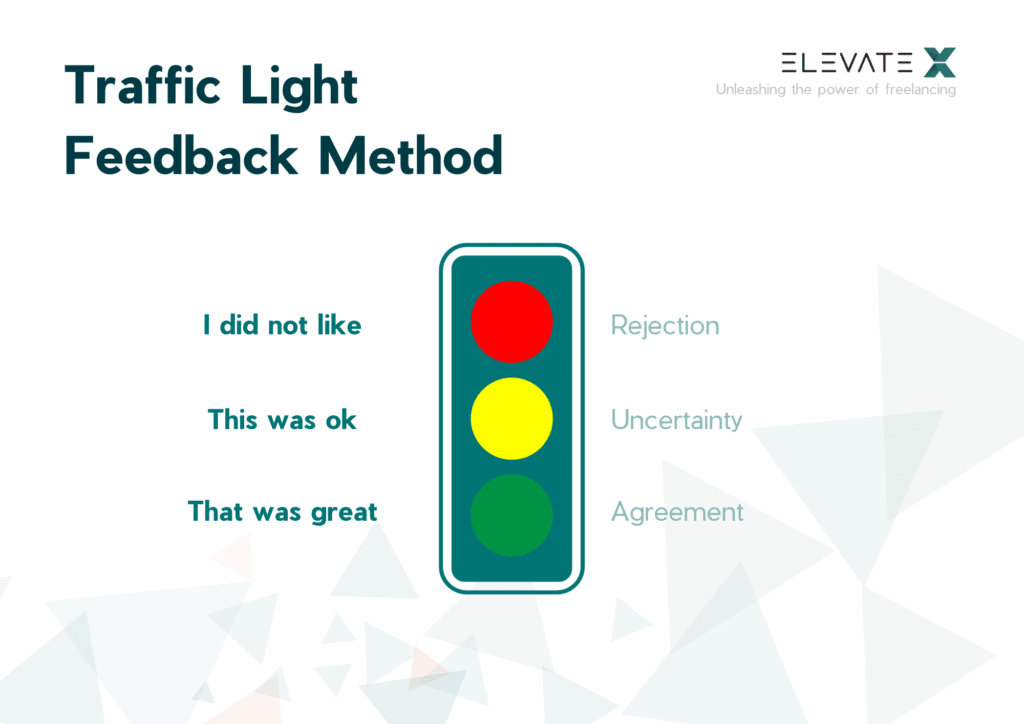
In addition to asking for opinions, attitudes, and personal perspectives on a specific question, the Traffic Light Feedback can also be used for joint decision-making or clarification processes. The method is particularly suitable for simpler questions that require quick decision-making.
How does it work?
Each person on the team receives a red, yellow, and green card, modeled after the colors of a traffic light. Green signifies agreement, yellow signifies uncertainty, and red signifies disagreement or rejection. After a question is posed, all participants hold up a card, allowing for a quick expression of the overall sentiment.
Example:
In a new product development project, the team presents first drafts. The Traffic Light Feedback Method is used: Green cards indicate promising aspects, yellow points out areas for improvement, and red signals serious concerns.
It is also possible to adapt the Traffic Light Feedback to digital environments. In virtual meetings, corresponding symbols or emojis can be used to signal agreement, ambivalence, or disagreement. This enables a flexible application of the method, even in remote teams.
A strong feedback culture can also improve collaboration with freelancers. Find the right IT freelancer for your next project!
The STATE Feedback Method
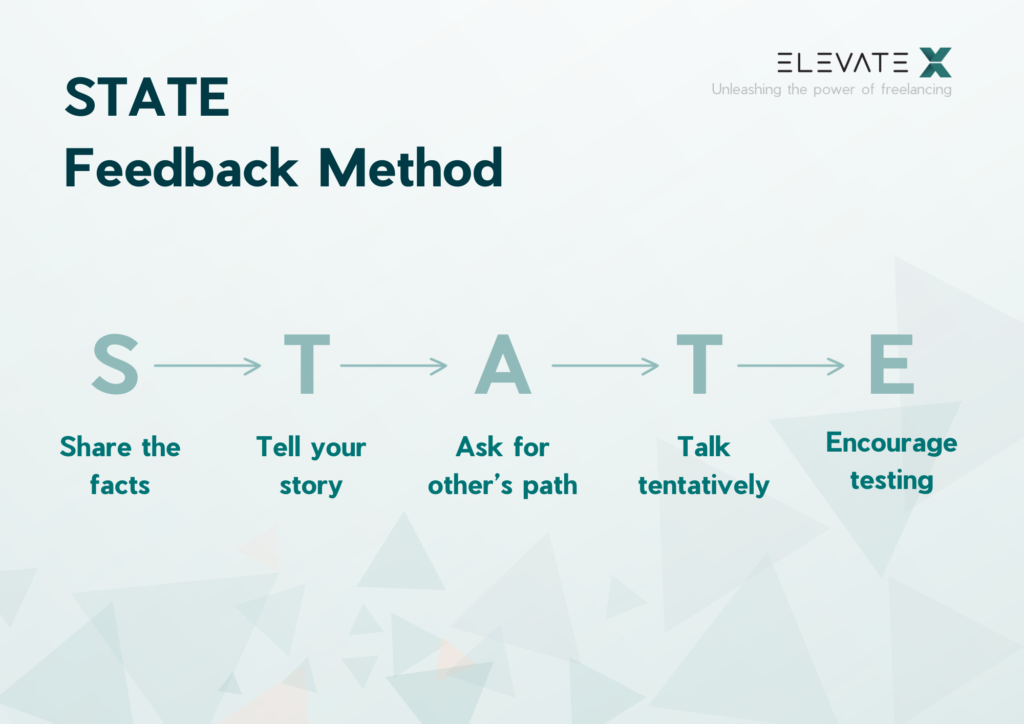
In communication, it’s often necessary to address sensitive topics. A method that has proven to be extremely effective in this regard is the STATE Method. It stands for Share, Tell, Ask, Talk, and Encourage.
How does it work?
Your share your perception, explain its impact, and ask others for their perception. The conversation proceeds objectively and thoughtfully, with the goal of better understanding the situation and the person involved.
“STATE” encompasses five steps that structure the process:
1. “Share the Facts”: Start the Conversation by Sharing Your Perception Objectively
Describe what you specifically observed without including interpretations. For example: “I have noticed that you contributed less in the last few meetings”.
2. “Tell Your Story”: Explain How This Perception Affected You
It is important to distinguish between facts and interpretations. For instance: “This made me thoughtful, as I’m usually very impressed with your ideas and contributions. I wanted to understand if there is a reason for this.”
3. “Ask for the Other’s Path”: Invite the Other Person to Share Their Perspective
Listen attentively, ask questions, and ensure a comfortable conversation environment. Example: “Could you please tell me if there are specific reasons for this? It’s important for me to understand if there’s something you might want to discuss.”
4. “Talk Tentatively”: Express Your Viewpoints Cautiously
This is especially important when it comes to interpretations, as they often don’t align with reality. Present them as such and avoid rigid assertions.
5. “Encourage Testing”: Emphasize Your Desire to Understand
Emphasize that your goal is to understand the situation, not to be right. Your counterpart should be encouraged to share their viewpoint and clarify potential misunderstandings. Example: “It’s entirely possible that I don’t see everything in this situation. Are there things I might be overlooking or not understanding?”.
The STATE Method allows for addressing sensitive issues while maintaining mutual respect. It promotes a constructive exchange on an equal footing and ensures that misunderstandings are minimized.
The Four Corners Feedback Method
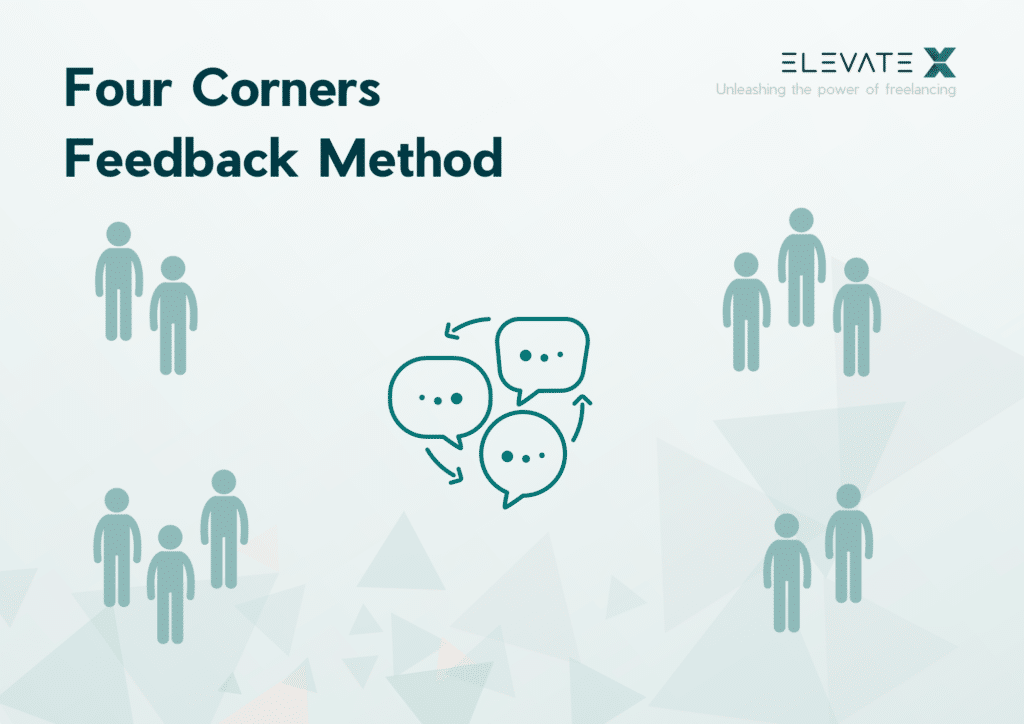
The Four Corners Method is a good way to structure feedback, especially in situations with different opinions.
How does it work?
Each corner of the room symbolizes a standpoint or feedback aspect (possibly also visualized through posters). Participants position themselves according to their opinion and interests in one of the four corners. Within these formed groups, arguments and experiences are exchanged. After this brief discussion phase, a representative from each group presents the key points.
Example:
In a new product development project, the team presents initial designs. The question now arises about which focus should be prioritized in product development. Technology and functionality, user-friendliness, cost optimization, or customer needs. Each of these four priorities is represented by a corner in the room, and employees position themselves according to their stance on the topic.
This method not only encourages open exchanges of views but also adds movement to the meeting. Individuals who usually keep a low profile find a better platform to express their opinions.
The Target Feedback Method
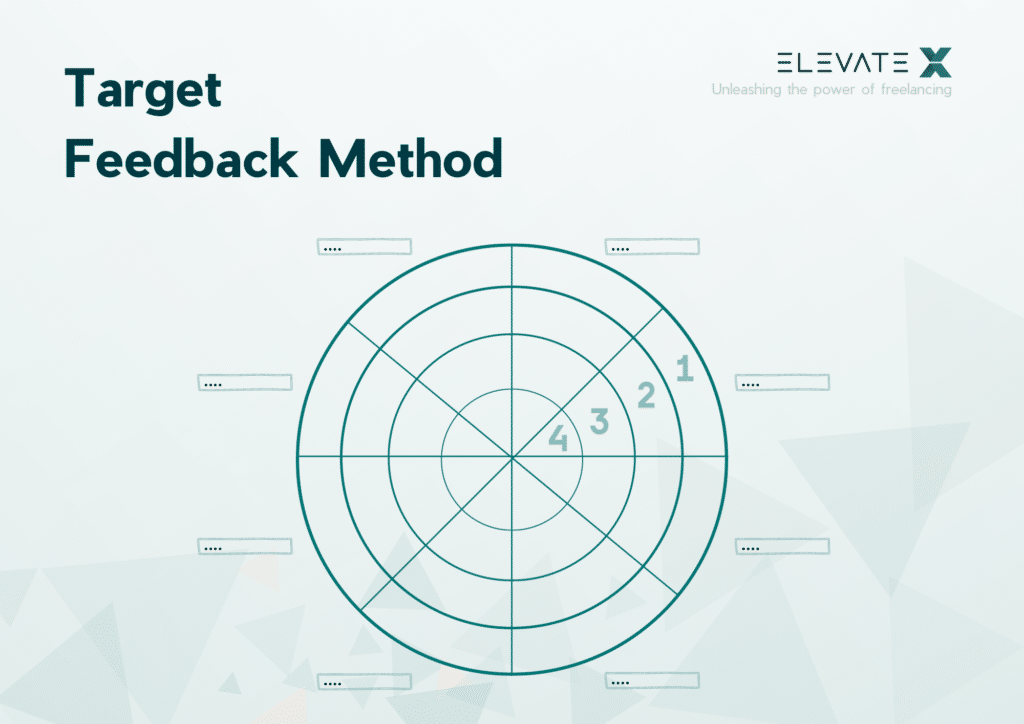
The Evaluation Target is an effective way to capture feedback visually.
How does it work?
Various evaluation aspects are represented in a circular diagram, similar to a target. The different circular segments represent different rating levels. The closer a circular segment is to the center, the more positive the evaluation level. Participants place points in the corresponding circular segments to provide their feedback. Afterwards, the results can be discussed together.
Example:
A workshop on team communication is to be evaluated. Evaluation aspects could include technical equipment, the quality of provided working materials, time management, the working atmosphere, or presentation style. These aspects are then evaluated on the target.
This visual representation allows for a quick overview of the assessments. The evaluation target offers a simple alternative to conventional questionnaires and facilitates the evaluation of the event or the feedback on it.
The 360-Degree Feedback Method
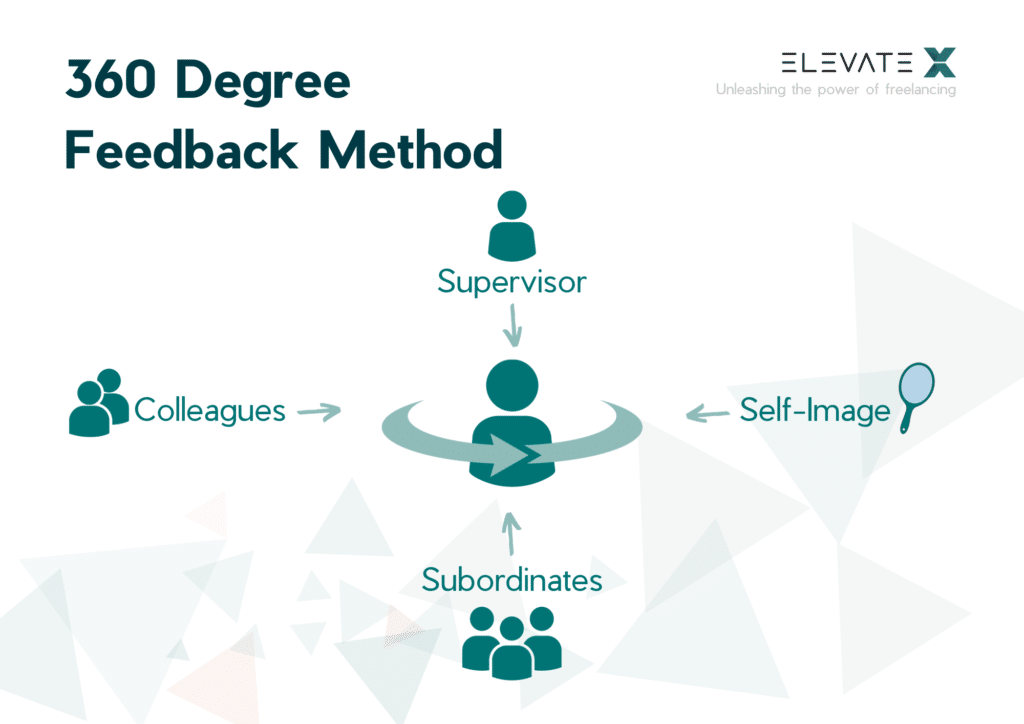
The 360-degree feedback method allows for a comprehensive assessment of individual performance. In contrast to traditional feedback, which often only considers the supervisor’s perspective, this method gathers feedback from various perspectives.
How does it work?
The person being evaluated receives feedback from superiors, colleagues at the same hierarchical level, as well as from direct subordinates, in order to obtain a holistic assessment. This comprehensive feedback provides valuable insights regarding strengths, areas for development, and overall performance.
The method promotes an open communication culture within the team, strengthens trust, and provides valuable insights into the individual impact on others. It also supports individual development and contributes to continuous improvement.
How to Choose the Right Feedback Method?
Feedback is an essential measure, but choosing the right method can be a challenge. Depending on the format and objective of the event, a different approach is required. The following questions can serve as guidance to make the appropriate selection for the respective format.
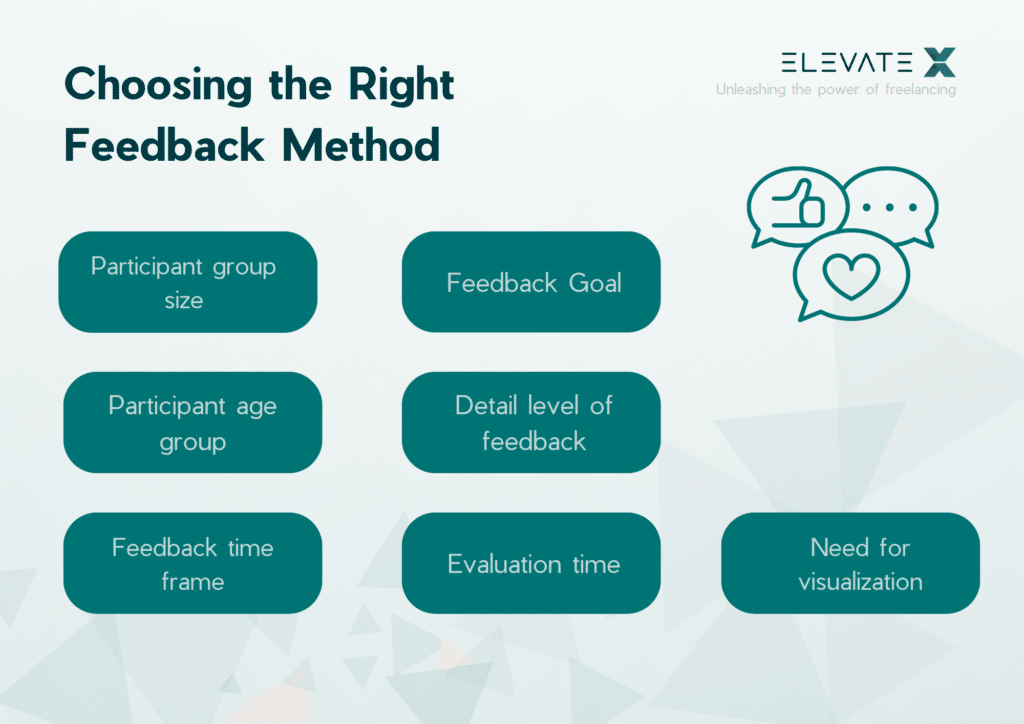
How Old Is the Participant Group?
Younger participants may prefer playful approaches, while older participants might prefer a factual approach.
How Big Is the Group?
The larger the group, the more important it is to choose a method that is scalable and efficient in collecting feedback.
How Much Time Should Participants Need for Their Feedback?
Determine how much time you want to give participants for their feedback. Methods like 360-degree feedback or the STATE method require significantly more time than the Traffic Light feedback method.
What Is the Goal of the Feedback?
Clarify the specific goal you are pursuing with the feedback collection. Do you want to optimize work processes, improve the effectiveness of teamwork, or evaluate overall employee satisfaction?
How Detailed Should the Feedback Be?
Decide how detailed you need the feedback to be. Some methods offer comprehensive insights, while others focus on a rough sentiment on a topic.
How Long Should the Evaluation of the Feedback Take?
Consider how much time you want to allocate for the evaluation of the received feedback. Some methods, such as the 5-Finger method, require more intensive analysis than others, like the Target Feedback method.
Is a Visual Representation of the Results Needed?
Consider whether a visual representation of the collected feedback is necessary to interpret and communicate the results more easily.
Conclusion
Feedback methods are an effective tool for managers and employees to represent sentiments and opinions. They also enable the initiation of clarification processes and the facilitation of decision-making. Given the many available feedback methods, it is important to choose the appropriate approach depending on the context and objective. By creating a feedback culture with open and trustworthy communication, the work atmosphere can be improved, and both individual and collective development can be promoted. Every company should be aware of the various feedback methods and leverage their potential for business success.
Good feedback should ideally be descriptive rather than judgmental, balanced with praise and constructive criticism, specific to particular situations, free from interpretations, and focused on behavior. It should also be actionable and not become personal.
There are various feedback methods, including the Five-Finger Feedback Method, the Traffic Light Feedback Method, the STATE Feedback Method, the Four Corners Feedback Method, and the 360-Degree Feedback Method. Each method has its own application areas and structures to effectively provide feedback.
The choice of the appropriate feedback method depends on various factors, such as the age group of the participants, the group size, the available time, the desired feedback goal, or the desired level of detail in the feedback. Depending on the context and objective, different methods are more suitable.








